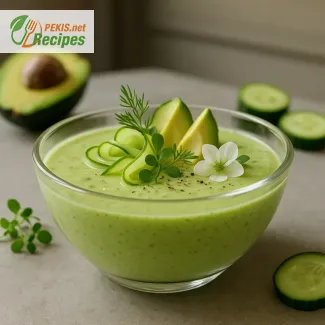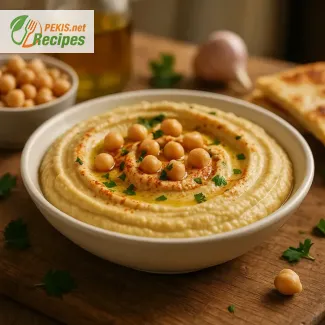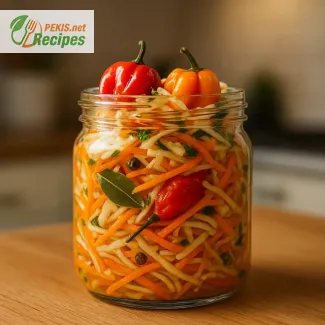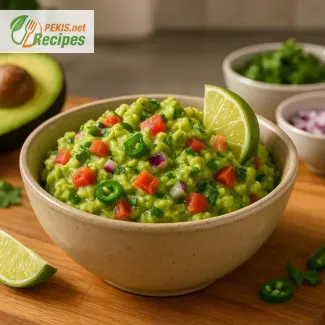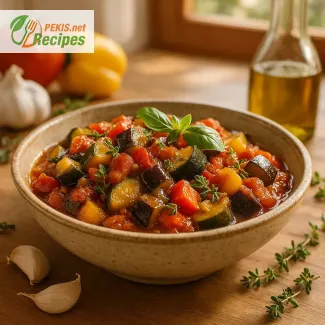
The Soul of Southern France in One Dish: Discover the Magic of Ratatouille
A celebration of summer vegetables, Provencal aromas, and rustic French charm
Few dishes carry the essence of a region as vividly as Ratatouille does for Provence. This vibrant vegetable medley, slowly simmered in olive oil, is much more than a side dish—it’s a sensory journey through the sun-drenched fields of southern France. Every bite reflects a tradition steeped in simplicity, seasonality, and heartfelt cooking. Whether you serve it warm, cold, as a main course or a companion to roast meats, Ratatouille never fails to impress with its deep flavor, rustic appeal, and versatile nature.
This Provençal classic isn't just a dish—it’s an ode to the culinary philosophy of the Mediterranean: eat what’s fresh, cook with care, and savor every moment. With each tender chunk of zucchini, meltingly soft eggplant, sweet peppers, and the unmistakable fragrance of herbs like thyme, basil, and oregano, Ratatouille embodies the perfect balance between rustic peasant fare and elegant French cuisine. Its origin may lie in the humble kitchens of Nice, but its reputation has transcended borders, finding its way into restaurants, home kitchens, and even Hollywood screens.
What makes Ratatouille especially appealing is its deep connection to seasonal cooking. At its best, it’s made in late summer when tomatoes are at their ripest, zucchinis are abundant, and eggplants are rich with flavor. These ingredients are gently sautéed or oven-roasted to develop their character, then layered or simmered together with aromatics like garlic and onion until they meld into a silky, colorful symphony. The result is a dish that is hearty yet light, comforting yet refreshing, rustic yet refined.
The charm of Ratatouille lies in its flexibility. While traditional versions may call for each vegetable to be cooked separately to preserve their texture and identity, others favor the one-pot method, where everything simmers together to form a flavorful harmony. Whichever method you choose, the goal remains the same: to highlight the natural sweetness, earthiness, and depth of each ingredient.
Ratatouille can be served in countless ways. Spoon it onto crusty bread for a rustic appetizer, fold it into an omelet for a hearty breakfast, or serve it over couscous, rice, or polenta for a wholesome vegetarian meal. It pairs beautifully with grilled meats, fish, or a simple poached egg on top. As it rests, the flavors deepen, making it one of those rare dishes that taste even better the next day.
Beyond its taste and versatility, Ratatouille is a story on a plate—a story of sun-drenched gardens, of families gathering around a table, and of a timeless culinary tradition that values freshness, patience, and love. In today’s fast-paced world, preparing Ratatouille offers a rare opportunity to slow down and reconnect with these values. The slow chopping, careful layering, and gentle simmering all become part of a ritual—one that rewards you with a meal that feels both nourishing and celebratory.
It’s no surprise that Ratatouille continues to gain popularity among food lovers, vegetarians, and fans of French cuisine. It’s beautiful in presentation, rich in flavor, and easy to adapt to individual preferences or dietary needs. Whether you’re looking to impress guests at a dinner party or simply elevate your weeknight meals, this dish delivers in every sense.
From the cobblestone streets of Nice to your kitchen table, Ratatouille is more than just a meal—it’s a culinary embrace from Provence, warm and welcoming. So gather your freshest vegetables, tie on an apron, and prepare to create a dish that will not only nourish your body but also delight your senses and warm your heart.
- Prepare the vegetables: Dice the eggplant, zucchini, bell peppers, and onion into even-sized pieces (about 2 cm / ¾ inch). Peel and chop the tomatoes. Mince the garlic.
- Sauté the aromatics: Heat 30 ml (2 tbsp) of olive oil in a large sauté pan over medium heat. Add the chopped onions and garlic. Cook for 3–4 minutes until translucent and fragrant.
- Cook the eggplant: Add the diced eggplant to the pan. Cook for 5–7 minutes, stirring occasionally, until lightly browned and slightly softened. Remove and set aside.
- Cook the zucchini and peppers: Add another 15 ml (1 tbsp) of olive oil to the same pan. Add the zucchini and bell peppers. Cook for 6–8 minutes until slightly golden and tender. Remove and combine with the eggplant.
- Simmer the tomato base: In the same pan, add 15 ml (1 tbsp) olive oil, chopped tomatoes, and tomato paste. Stir in thyme and oregano. Cook for 8–10 minutes until the tomatoes break down and the sauce thickens slightly.
- Combine all vegetables: Return the sautéed vegetables to the pan. Season with salt and black pepper. Mix well to coat all ingredients in the tomato base.
- Simmer gently: Reduce heat to low, cover with a lid, and cook for 20–25 minutes, stirring occasionally, until all vegetables are soft but not mushy.
- Finish with basil: Remove from heat and stir in the chopped fresh basil. Let the ratatouille rest for 10 minutes before serving to allow flavors to meld.
- Serving suggestions: Serve warm as a main dish with crusty bread or as a side to roasted chicken or fish. Also delicious served cold or at room temperature the next day.
Rustic Provençal Harmony on a Plate: Why Ratatouille is the Ultimate Summer Comfort Food
A timeless French vegetable recipe full of color, flavor, and heart
There are few dishes in the world that express the soul of a region quite like Ratatouille. This vibrant Provençal creation is not just a vegetable stew—it is a celebration of the Mediterranean sun, soil, and slow living. Rich in both color and flavor, Ratatouille brings together a chorus of seasonal vegetables, herbs, and fragrant olive oil, creating a dish that is both humble and deeply satisfying.
Ratatouille, with its roots in southern France, particularly in Nice, captures the essence of a lifestyle that values simplicity, freshness, and the joy of shared meals. Originally a dish for farmers and field workers, Ratatouille has grown into a beloved staple in both French households and international kitchens. Its charm lies in its versatility, its deep, layered taste, and the emotional warmth it radiates through its comforting aroma and rustic appeal.
Made from eggplants, zucchinis, bell peppers, tomatoes, onions, and garlic, all gently cooked until tender and harmoniously melded, Ratatouille is proof that the most delicious food often comes from the simplest ingredients. Each vegetable plays its role, offering its unique texture and flavor—zucchini brings a light sweetness, eggplant a soft earthiness, tomatoes their juicy tang, and peppers a vibrant bite. The addition of aromatic herbs like thyme, basil, and oregano elevates the dish, making it a true reflection of the Provencal countryside.
In France, Ratatouille is not merely a dish—it is an experience. Served warm with a drizzle of extra virgin olive oil, or chilled as a summer salad, it can be a hearty vegetarian main course, a vibrant side dish, or even a topping for pasta, rice, or crusty bread. Its adaptability means it can be enjoyed at any time of day and prepared in countless ways—from the rustic, one-pot method to the elegantly layered, oven-roasted presentation seen in haute cuisine.
What makes Ratatouille truly special is its ability to be both comfort food and culinary art. The beauty of this dish lies in its texture balance—each vegetable is cooked just enough to maintain its identity, yet blends seamlessly into the whole. This harmony of ingredients mirrors the values of the region it hails from: community, nature, and simplicity.
The dish has become especially popular among those seeking plant-based meals that don’t compromise on flavor. It’s gluten-free, naturally vegan, and packed with wholesome ingredients, making it suitable for a variety of dietary lifestyles. With the rising appreciation for sustainable cooking and seasonal eating, Ratatouille stands out as a perfect example of how traditional recipes can support modern values.
Another layer of appeal comes from its beautiful presentation. When served, Ratatouille’s medley of colors—from the deep purple of eggplant to the golden hues of peppers—makes it as pleasing to the eye as it is to the palate. Whether spooned generously onto a plate or meticulously arranged in a circular pattern, its rustic charm always shines through.
Beyond its culinary virtues, Ratatouille tells a story—a story of seasonal abundance, of hands harvesting vegetables from sun-drenched fields, of kitchens filled with laughter and the smell of herbs simmering slowly. It reminds us of the importance of taking time with food, of preparing meals not just to eat, but to nourish and to celebrate.
From a health perspective, Ratatouille is also a powerhouse. Its ingredients are known for their richness in fiber, vitamins, and minerals, contributing to a balanced and fulfilling diet. But perhaps its greatest benefit is emotional: it brings a sense of peace, warmth, and joy, evoking the relaxed afternoons and balmy evenings of southern France.
Whether you’re recreating it as part of a themed French dinner, serving it at a casual summer gathering, or meal-prepping a healthy week of lunches, Ratatouille delivers every time. Its simplicity is its strength, and its flavor lingers long after the last spoonful. In a world where speed often overshadows tradition, this Provençal classic offers a gentle reminder to slow down and savor the moment.
Allergens present: None directly, but check tomato paste and spices for processed additives or traces.
Contains gluten: No.
Tips for allergens and gluten substitution: This recipe is naturally gluten-free and vegan. Always check labels on tomato paste and spice blends to avoid hidden gluten or allergen contamination.
- Vitamin C: 89 mg – Supports immune function, improves iron absorption
- Vitamin A: 1185 IU – Important for eye health and skin
- Vitamin K: 18 µg – Helps with blood clotting and bone strength
- Potassium: 550 mg – Supports nerve function and heart rhythm
- Folate: 40 µg – Essential for cell growth and DNA formation
- Iron: 2.2 mg – Vital for oxygen transport in blood
- Magnesium: 38 mg – Regulates muscle and nerve function
- Manganese: 0.5 mg – Antioxidant support, bone formation
- Lycopene (from tomatoes): 6.5 mg – Linked to reduced risk of heart disease and some cancers
- Beta-carotene (from peppers and zucchini): 2.4 mg – Protects cells from oxidative stress, converts to vitamin A
- Flavonoids (from basil, onion): 12 mg – Anti-inflammatory, supports cardiovascular health
- Polyphenols (from eggplant skin): 8 mg – Supports cellular repair and brain health
